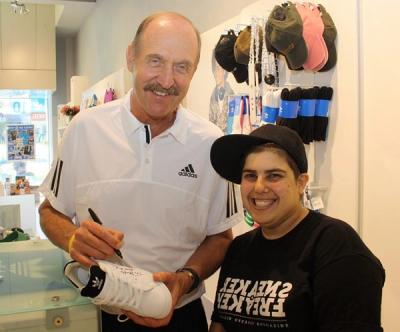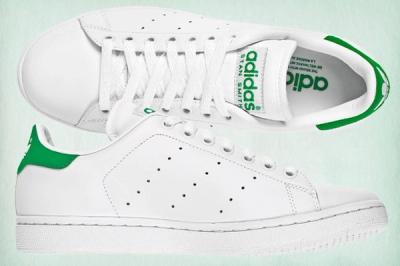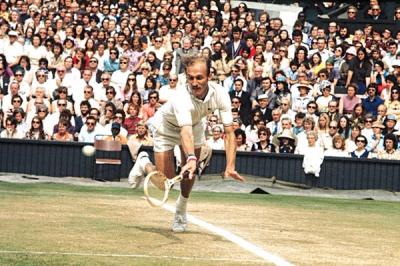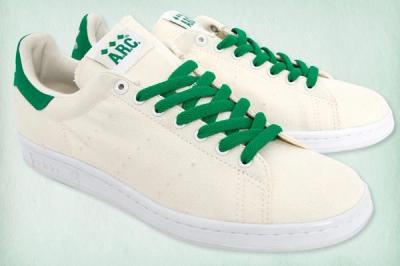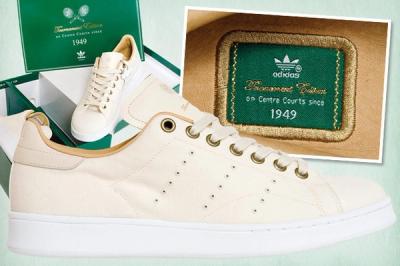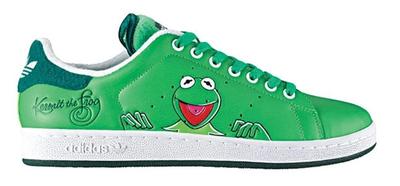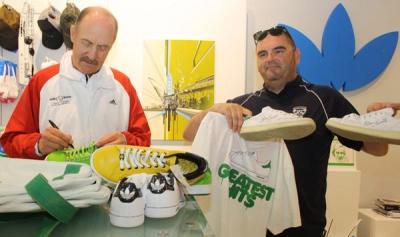Grand Slammin' With Stan Smith!
is tennis royalty. He won 39 singles titles over his whole career, including both the US Open and Wimbledon. He’s righteously old now, but in his day he was fierce! Sneaker aficionados will immediately associate Stan’s alliterative name with one of the earliest ‘signature’ player models. The ‘Stan’ as it became known, was as simple as simple can be and was distinctive for what it didn’t have – the traditional adidas Three Stripes. Rather, the shoe was embellished with linear perforations that were perfectly understated and complemented the low profile, slimline tennis silhouette. Since its debut in 1971, over 30 million pairs have been sold! We managed to lob Stan a few questions when he came to our part of the world...
Hey Stan, we think we’re pretty lucky to live in a Grand Slam town. When was the last time you were in Melbourne?
Last year. I’ve been coming back here for ten years and, of course, I played here four or five times in the Australian Open. We played Davis Cup here in 1968, actually. I’ve also got fond memories of Sydney especially; we were there for a month during the Olympics.
You never lost the passion for tennis?
Well you know if you stay reasonably healthy, you can still play. If you get an injury then you’re struggling with it, but tennis players can play for a long time.
Is there a good camaraderie between the older tennis players?
Yeah, absolutely. I mean there’s been so many great Australians over the years – players like Sedgeman, McGregor and Frasier. I knew Newcombe, Roach, Stolly, Emerson, Laver and Rosewall. And then you’ve got guys like Pat Cash too. I’ve gotten to know all of them very well, not only those fellows but also others that played at the same time. In general the Australian players have been great advocates of fighting as hard as you possibly can on the court, and then once the match is over you go and have a couple of beers together. So that’s sort of been the mentality, especially with the older players that I came up with. With other players from other countries, you know, it hasn’t been quite the same. But certainly the Australians in general have been great sportsmen; they really play it the right way.
Good to hear! So when did adidas first approach you about making a Stan Smith shoe?
It was in 1971 when we first started talking. They really wanted to get into the US market with adidas. I was the best player at the time and was a natural fit, so my name went on the shoe in 1972.
Right, because it was a different shoe at the time wasn’t it? It was the actually called the Haillet.
Yes, it was named after Robert Haillet. He had worked closely alongside Horst Dassler, the son of Adi Dassler who is, as you know, the creator of adidas. Horst and Robert Haillet had developed this original leather tennis shoe, the first leather tennis shoe ever made. They actually had both of our names on the shoe for a while, but eventually they moved his name off the shoe and put my name solely on the sneaker. But for a couple of years there, from ’72 to’74, both of our names were on the shoe. My name and picture were on the tongue and his name was on the side of the shoe.
That seems a bit odd. Why did they phase Robert out?
Well because our agreement was that it was going to be the Stan Smith shoe and not anything else. He was the number one French player at the time and good friends of Horst Dassler and they really created the shoe together.
So was there any tension there?
Well not from my point. A couple of years ago, the Guinness Book of Records presented adidas with a certificate showing 22 million pairs of shoes sold and he was at that dinner as it was held in Paris. We have a friendly kind of a thing, you know. My name is there on the shoe but in all honesty, if you were to talk to a young person today, a lot of them would not even know who I am. They just know the name from the shoe.
Does that bother you at all?
No, that’s just the way it is. I mean I’ll never forget giving a clinic to a bunch of 10-year-old kids. It was about two years after Borg retired. I said to them, ‘who wants to be the next Bjorn Borg?’ And they looked at me like I was nuts. So that was a quick realisation that that’s what happens. I wouldn’t expect young people to know who I am. Jack Kramer was in the same boat. I don’t know if you know who Jack Kramer was, but he was one of the great players of all time. He’s had a racquet out for 50 or 60 years now and although most people would not know who Jack Kramer is, they probably know the racquet. That’s just the way it is.
At this time not many athletes had their name on a shoe...
Yeah, I was one of the first. Of course there was the Chuck Taylor Converse. There’s also a Jack Purcell that had his name on it. Those were basketball shoes but even then the naming idea was not real big at the time. I also had my own clothing line with my name on it. Then about 10 years after the shoe first dropped, I started wearing the adidas Trefoil. I was involved in helping promote adidas in any way, not just on the tennis side of it.
And it still goes on today…
Yeah, still doing that. I’m going to Asia for the 60th anniversary of Soles and Stripes.
So this has been a mutually beneficial relationship for the two of you then?
Yeah! The shoe has sold really well in Japan and other cities in Asia plus in Europe – Italy, Spain and England. From my perspective, it’s a little bit like Federer said the other day, that he’s living the dream. I mean there’s no real reason why my name would ever be on a sneaker, but the shoe is a classic – it’s a clean-cut look and you can wear it with jeans or a tuxedo. And now the new Stan Smiths are coming out with all sorts of different colours and patterns. You can still see it’s the same basic shoe but it’s revamped. I picked up some of my shoes in Paris two years ago that were red with white polka dots, black with white polka dots, pink with white polka dots. I mean it’s crazy.
Ha, very nice! Fashion and style has come full circle now with less branding being put on shoes, they’ve stripped it all right back. With your shoe, there were no stripes, the Trefoil was on the heel and your face was on the tongue tag. Was that a conscious move for adidas to go that way or was it just because tennis in this era had a much simpler aesthetic?
Bit of both. The perforations on the side were to help let your foot breathe. And in fact, I remember playing in heat, especially with intense humidity, and the shoe would get totally wet and the water would actually squirt out of those little holes. That was brutal to play in conditions like that. You know, Wimbledon also used my shoe and they put three green stripes on it. They put a herringbone bottom on the shoe because that would hold up better on the grass and they gave it to all the adidas players.
Did it still look like a Stan Smith?
It did except for the three stripes. And of course, when you looked at the bottom, it was completely different. That kind of sole was done for about 10 to 15 years before they changed the rule, which let you have studs coming from the bottom of the sole. Over a five-year period, all the brands had to eventually create a shoe that had the same bottom on the shoe so that no one had any advantage on the court.
So what are you doing now? You’ve got your own tennis school?
Yeah, I’ve got this tennis academy. And I started a company called Stan Smith Events where we help corporations entertain their clients at major events, tennis events, golf events and the Olympics. And then we put together special weekends for a company to bring some of their top guests in. We have been doing that for about 12 or 13 years alongside working with adidas.
You’re a brand! It’s quite an empire.
Yeah. I also have a Stan Smith design company where we design tennis facilities. I’ve also got four kids who have all played tennis. The youngest one is a senior in college and she’s captain of her team. It’s the last time my wife and I will be seeing them play tennis at all which is sad in a way. We’ve been following their tennis careers since the oldest one was playing, he’s 30 now, so it’s been 20 years since they started.
Well I know it’s going to be hard, but if you could, can you pinpoint the biggest highlight of your career? There were many, I’m sure…
Well, you know, winning Wimbledon was pretty cool. I lost to Newcombe in the finals in ’71 and beat Nastase in the finals in ’72, so that was, in my mind, like being the world champion to a certain extent. And even the Australians, they would say the same thing. Most Americans would say the same thing. Some of the Europeans would say the French over Wimbledon, but even when Nadal won Wimbledon he said that that was the tournament he really wanted to win even though he won the French four times! So that was a big one. Playing Davis Cup was another highlight – I was on seven winning teams, so it was pretty special. The one match we had in Bucharest against Nastase at the ’72 Davis Cup (11-9, 6-2, 6-3) was the most difficult competitive situation that I was ever in.
Thanks Stan!


